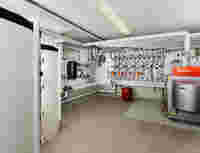The Key to Greater Efficiency

Integrative building concepts: Lanfer Automation unifies the varying systems of individual building technology sectors via the WAGO I/O System 750.
Smart buildings significantly reduce energy consumption. Thus, it is truly smart for all the technical components to be intelligently networked. Lanfer Automation GmbH, based in Borken, Germany accomplishes this using WAGO Controllers. The result is not just energy savings, it also opens up energy synergies.
Alfred Lanfer scans a QR code on a conference room’s door with his smartphone in order to prepare for the next meeting. With just one finger swipe on a tiny screen, the blinds lower, the lights dim and a projector and screen descend from the ceiling. “This is the presentation function that we were able to create with just one switch by using EnOcean technology,” explains the CEO of Lanfer Automation GmbH. This small, concerted display of technical finesse is just one piece of what the project developer, located in the Westphalian town of Borken, can do. The company completely renovated its headquarters in late 2013, in which the building was equipped with innovative automation technology – from cellar to ceiling – and targeted energy efficiency. It would be easy to view the entire office building as one big showroom. “Technologically, a lot more can be done today than is conventionally implemented,” explains Lanfer. And the company from Borken wants to demonstrate just what can be done. However, the building does not just reflect the visionary philosophy that led to the company’s founding in 1979; the project also reveals a groundbreaking change in the design and networking of technical systems.
Lanfer Automation:
- Linking Intelligent Islands
- Getting a Grip on Interface Problems
- Web-Based Energy Monitoring





